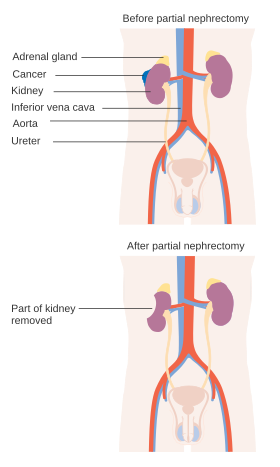Nephrectomy
| Nephrectomy | |
|---|---|
| Intervention | |

Before and after a radical nephrectomy
|
|
| ICD-9-CM | 55.5 |
| MeSH | D009392 |
| OPS-301 code | 5-554 |
| Partial Nephrectomy | |
|---|---|
| Intervention | |

Before and after a partial nephrectomy
|
|
| ICD-9-CM | 55.4 |
| MeSH | D009392 |
| OPS-301 code | 5-554 |
Nephrectomy is the surgical removal of a kidney. See below for partial nephrectomy.
The first successful nephrectomy was performed by the German surgeon Gustav Simon on August 2, 1869 in Heidelberg. Simon practiced the operation beforehand in animal experiments. He proved that one healthy kidney can be sufficient for urine excretion in humans.
There are various indications for this procedure, such as renal cell carcinoma, a non-functioning kidney (which may cause high blood pressure) and a congenitally small kidney (in which the kidney is swelling, causing it to press on nerves which can cause pain in unrelated areas such as the back). Nephrectomy for renal cell carcinoma is rapidly being modified to allow partial removal of the kidney. Nephrectomy is also performed for the purpose of living donor kidney transplantation. A nephroureterectomy is the removal of a kidney and the entire ureter and a small cuff of the bladder for urothelial cancer of the kidney or ureter.
The surgery is performed with the patient under general anesthesia. A kidney can be removed through an open incision or laparoscopically. For the open procedure, the surgeon makes an incision in the side of the abdomen to reach the kidney. Depending on circumstances, the incision can also be made midline. The ureter and blood vessels are disconnected, and the kidney is then removed. The laparoscopic approach utilizes three or four small (5–10 mm) cuts in the abdominal and flank area. The kidney is completely detached inside the body and then placed in a bag. One of the incisions is then expanded to remove the kidney for cancer operations. If the kidney is being removed for other causes, it can be morcellated and removed through the small incisions. Recently, this procedure is performed through a single incision in the patient's belly-button. This advanced technique is called single port laparoscopy.
...
Wikipedia
